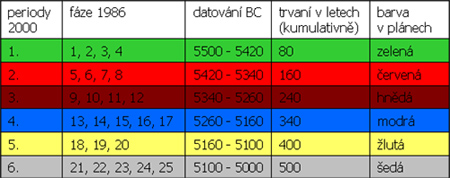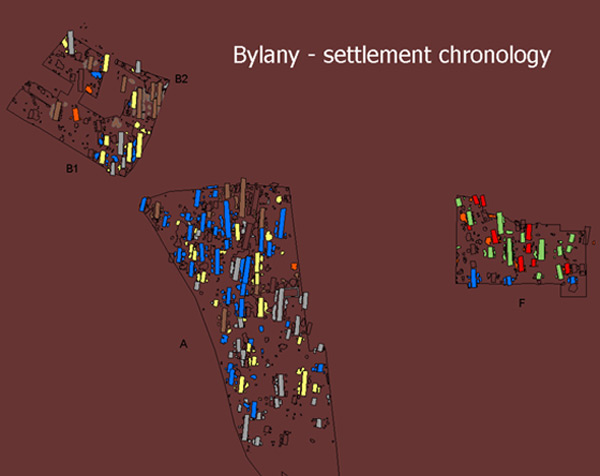Bylany.com >> Bylany
Bylany - Settlement chronology
Settlement of LBK dating covers at Bylany the time interval 5350–4900 BC, and consists of settlement area remains in the form of posts ground plans of above-ground structures and features. Three discrete areas designated as sections A, B, and F have been discovered during archaeological excavations. The most extensive (44 693 m2) is the section A; furthermore, section B covers 13 409 m2, and section F 11 878 m2. The following table clearly shows summary of preserved houses ground plans, and archaeological features in individual sections.

On the settlement, a basic spatial-chronological unit represents a household complex. consisting of a post-house ground plan with adjoining features located approx. in 5 m distance from supposed walls of the house. The distance of 5 metres was defined on the basis of empirical principles founded on presumption that the so-called building pits were usually dug in this distance from appropriate houses (Pavlů 1977, 13).
On the basis of individual household complexes sequence and inner chronology of pottery from the settlements, respectively chronological arrangement of obtained objects and features, the LBK culture settlement was divided into 25 building and chronological phases. Original settlement phases represent artificial temporal intervals with ascribed common constant duration of 20 years for each of them. This constant forms a relative time scale, and represents a single generation of population during which houses were reconstructed. However, these reconstruction were not mutually synchronized, and, thus, the absolute beginning of contemporaneous structures is not coincident.
Phases serve as plausible representations of functionally and, in the given time horizon, also chronologically imminent present settlement units. However, these short chronological units can not be used for detailed analyses since they were not created on the basis of other than ceramic artefacts. If other artefact types (hand mills, flint industry, ground stone industry, etc.) are incorporated in this typo-chronological classification, a series of six time periods is achieved (BYLIFE, 270). They involve at all times several phases, and can be seen as expressions of local history of archaeological finds as correlates of previous events. These periods manifest themselves in particular analytic layers with identical interruptions of distinct short-time consistent development that was identified for the first time on dynamics of hand-mills occurrence. The following table shows mutual correlation of periods and phases of settlement at Bylany. Furthermore, colour differentiation of individual periods in plans is also indicated.



